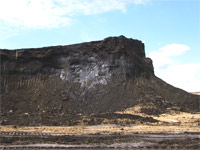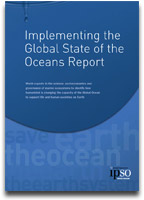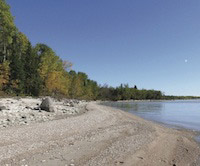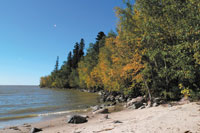
News |
- Polar Bears To Be Listed Under SARA
- Proposed Energy Plan Could Warm Planet 6 Degrees
- Urgent Action Required to Preserve Oceans
- Canada's Woodland Caribou Going Extinct
- White House Tar Sands Decision Under Pressure
- New Sustainable Hydropower Protocol
- Finally! Fisher Bay Park Receives Permanent Protection
- Bloodvein Pimitotah Lands Plan Now Public
- Canada Sues Manitoba Hydro
- Lake Winnipeg Regulation Hearings Announced
- U.S. Court Upholds Polar Bear Protection
- Premiers Establish Water Stewardship Council
| Polar Bears To Be Listed Under SARA | 27 July 11 |
 On July 2, 2011 the government of Canada gave notice of intention to list the polar bear as a species of special concern under the Species At Risk Act (SARA). The proposal will undergo a 30-day public comment period.
On July 2, 2011 the government of Canada gave notice of intention to list the polar bear as a species of special concern under the Species At Risk Act (SARA). The proposal will undergo a 30-day public comment period.Special concern status is the least critical level of Canada’s Species at Risk list. It is an omnibus category for species that are not threatened or endangered, but could become so if the factors threatening them are not reversed. If approved as a species of concern, a plan would be devised within three years to prevent polar bears from becoming endangered or threatened. The legislative move comes almost three years after the Committee on the Status of Endangered Wildlife (COSEWIC) recommended the bear needed special attention. Canada is home to 60 per cent of the world’s polar bears and changes in sea ice conditions are wreaking havoc with bear populations. Aboriginal groups in the North strongly oppose inclusion of the bear under the law, saying populations are growing. View Government of Canada, Species at Risk Public RegistryView COSEWIC, Wildlife Species Search: Polar Bears View July 13, 2011 CTV News article View July 12, 2011 Canadian Press article View July 12, 2011 CBC News article View Manitoba Wildlands Biodiversity & Species page Sources:
Canadian Press
|
|
 Print version Print version |
Top |
| Proposed Energy Plan Could Warm Planet 6 Degrees | 23 July 11 |
 Canada's federal, provincial and territorial energy ministers gathered at an oil industry sponsored meeting in Kananaskis, Alberta July 19th, where they adopted a national energy strategy that uses the "Current Policies" scenario published by the International Energy Agency (IEA) in their World Energy Outlook 2010. This scenario, which forms the basis of underlying assumptions for the Ministers' strategy, assumes 6 degrees of global warming which results in obvious catastrophic effects.
Canada's federal, provincial and territorial energy ministers gathered at an oil industry sponsored meeting in Kananaskis, Alberta July 19th, where they adopted a national energy strategy that uses the "Current Policies" scenario published by the International Energy Agency (IEA) in their World Energy Outlook 2010. This scenario, which forms the basis of underlying assumptions for the Ministers' strategy, assumes 6 degrees of global warming which results in obvious catastrophic effects.The strategy for a national energy strategy fails to take meaningful steps towards a low-carbon future and instead supports Canada's fastest growing source of industrial pollution, the oil sands. The plan barely supports renewable energy and energy efficiency and pays lip service to reducing greenhouse gas emissions. The ministers' meeting failed to achieve consensus after Ontario disagreed with language calling the oil sands a 'responsible and major supplier of energy to the world'. We just weren't comfortable with the wording that the oil sands are sustainable and responsible," Ontario Energy Minister Brad Duguid Quebec then stepped up and also objected to the energy strategy. The controversial energy plan impacted the discussion at the Canadian Premiers meeting, known as the Council of the Federation, held in Vancouver July 20-22. "Well, how about using Canadian tax dollars to support clean energy industry that is taking place, that is developing – we're at the forefront in North America, we're creating thousands of jobs, we're reducing our contribution to climate change. We're shutting down coal-fired plants," said Ontario Premier Dalton McGuinty in reference to subsidies given to western oil fields, particularly the emission intense oil sands. View July 21, 2011, July 19, 2011, and July 19, 2011 Globe and Mail articlesView July 19, 2011 Canada's Annual Energy and Mines Ministers' Conference release (PDF) View July 19, 2011 Pembina Institute release (PDF) View July 20, 2011 Greenpeace blog post View July 20, 2011 Climate Action Network release View July 18, 2011 Environmental Defence Sources:
Climate Action Network, Globe and Mail, CANET
|
|
 Print version Print version |
Top |
| Urgent Action Required to Preserve Oceans | 23 July 11 |
 A study from the International Programme on the State of the Ocean (IPSO), tells us the combined effects from overfishing, fertilizer run-off, pollution, and ocean acidification from carbon dioxide emissions are putting much marine life at immediate risk of extinction.
A study from the International Programme on the State of the Ocean (IPSO), tells us the combined effects from overfishing, fertilizer run-off, pollution, and ocean acidification from carbon dioxide emissions are putting much marine life at immediate risk of extinction.The 27 scientists from 18 organizations in six countries reviewed scientific research from around the world and concluded the looming extinctions are "unprecedented in human history" and have called for "urgent and unequivocal action to halt further declines in ocean health." The main factors are effects from the "deadly trio": climate change, ocean acidification, and lack of oxygen. Overfishing and pollution add to the problem. "The findings are shocking. As we considered the cumulative effect of what humankind does to the ocean the implications became far worse than we had individually realized. This is a very serious situation demanding unequivocal action at every level," said Alex Rogers, scientific director of IPSO. "This study shows we cannot look at ecosystems, species, and environmental problems in isolation. This research points out that combined impacts of all the stressors are far more severe than what scientists might conclude by looking at individual problems," said David Suzuki. "The time to protect the blue heart of our planet is today, now and urgent" said Dan Laffoley, Marine Chair of International Union for the Conservation of Nature (IUCN) World Commission on protected areas and Senior Advisor on Marine Science and Conservation for IUCN. View June 29, 2011 David Suzuki articleView June 24, 2011 EcoSanity blog View June 20, 2011 International Programme on the State of the Ocean report (PDF) View June 20, 2011 International Programme on the State of the Ocean press release (PDF) View June 20, 2011 Guardian article Sources:
David Suzuki
|
|
 Print version Print version |
Top |
| Canada's Woodland Caribou Going Extinct | 23 July 11 |
 Woodland caribou existence in Canada is threatened by industrial development and piecemeal protection efforts that have not curbed habitat loss. Century-long decreases in woodland caribou populations continue says a new report by the International Boreal Conservation Science Panel.
Woodland caribou existence in Canada is threatened by industrial development and piecemeal protection efforts that have not curbed habitat loss. Century-long decreases in woodland caribou populations continue says a new report by the International Boreal Conservation Science Panel.The report, Keeping Woodland Caribou in the Boreal Forest, is authored by 23 biologists and other researchers from Canada and the U.S. It was released when Canadian and American environmentalists appealed to Canadian Premiers and Prime Minister Stephen Harper to take action on a political level to prevent extinction of the woodland caribou.. "Their concern is legitimate," said Canadian Environment Minister Peter Kent adding, "in some places the numbers [of woodland caribou] have diminished to the point where regional or sub-regional recovery plans may require fairly drastic protective action." Caribou were first listed under the Canadian Species At Risk Act (SARA) in 2003. Woodland Caribou were legally protected as threatened under Manitoba's Endangered Species Act (ESA) in 2006. "For caribou to survive and prosper, it will be critical for Manitoba to incorporate state of the art scientific analysis into management planning efforts in the remainder of the boreal forest, particularly in the region of the Tolko Forest Management Agreement," said the Canadian Boreal Initiative (CBI) and Pew Environment Group in a letter to Manitoba Premier Greg Selinger. "What we need is collaboration between federal, provincial, territorial and aboriginal governments and support from industry and conservation organizations," said Larry Innes, executive director of the CBI. View more on Manitoba Wildlands Biodiversity and Species pageView July 14, 2011 Ottawa Citizen article View July 14, 2011 Winnipeg Free Press article View July 14, 2011 Vancouver Sun article View July 13, 2011 Globe and Mail article View July 13, 2011 CBI/Pew letter to Greg Selinger (PDF) View July 2011 Keeping Woodland Caribou in the Boreal Forest (PDF) View Species At Risk Publis Registry documents View June 18, 2011 Manitoba Wildlands Reality Check #14: Does Manitoba Have a Woodland Caribou Recovery Strategy? Sources:
Ottawa Citizen, Canadian Boreal Initiative
|
|
 Print version Print version |
Top |
| White House Tar Sands Decision Under Pressure | 16 July 11 |
 TransCanada Keystone XL pipeline, if approved, will move 900,000 barrels per day of crude oil from oil sands in northern Alberta, Canada, to the Gulf of Mexico, travelling through two provinces and six states before reaching refineries in Houston and Port Arthur, Texas, U.S.A.
TransCanada Keystone XL pipeline, if approved, will move 900,000 barrels per day of crude oil from oil sands in northern Alberta, Canada, to the Gulf of Mexico, travelling through two provinces and six states before reaching refineries in Houston and Port Arthur, Texas, U.S.A.Canada's National Energy Board approved the $7 billion project in March 2010. U.S. approval has been more problematic. The decision rests with the State Department, but the U.S. Environmental Protection Agency has been chastising the State Department's environmental review, pushing for further review and public hearings. In a June 2011 letter to the State Department the EPA said it remains concerned about risk of oil spills that could affect drinking water and sensitive ecosystems, as well as greenhouse gas emissions associated with the Keystone XL pipeline. The pipeline enables Alberta oil sands expansion, the most emissions intense oil production on the planet. The State Department has promised a decision by the end of 2011. Statements by Secretary of State Hillary Clinton and President Barrack Obama, along with leaked cables from the U.S. Embassy in Ottawa, suggest the State Department maybe in favour of the project. But recent pipeline oil spills, including at least 12 reported spills on TransCanada owned pipelines since May 2010, has increased public scrutiny on the proposed Keystone XL. University of Nebraska-Lincoln engineering professor John Stansbury, who teaches U.S. Army Corps of Engineers how to do risk assessments, predicts the pipeline would have 91 significant spills over 50 years, not the 11 spills TransCanada predicts. Stansbury observes that neither TransCanada nor the regulators evaluating the proposed Keystone XL pipeline have properly considered the risks. 350.org founder Bill McKibben and supporters are issuing a call to action for three weeks of peaceful demonstrations in Washington DC between August 20 and September 3, 2011 to convince President Obama not to approve the TransCanada Keystone XL pipeline. View July 14, 2011 Death and Taxes Magazine articleView July 14, 2011 Nebraska State Paper article View July 13, 2011 L.A. Times article View July 11, 2011 Associated Press coverage View July 8, 2011 Time Magazine blog View July 6, 2011 and July 7, 2011 Huffington Post coverage View June 27, 2011 Reuters coverage Sign Up Tar Sands Action: Aug 20 - Sept 3, 2011, Washington, D.C. View February 12, 2011 Manitoba Wildlands news item View November 3, 2010 Manitoba Wildlands news item View September 7, 2010 Manitoba Wildlands news item View August 4, 2010 Manitoba Wildlands news item |
|
 Print version Print version |
Top |
| New Sustainable Hydropower Protocol | 16 July 11 |
 The International Hydropower Association (IHA) held its biannual World Congress on Advancing Sustainable Hydropower in Iguaçu, Brazil June 15-17, 2011.
The International Hydropower Association (IHA) held its biannual World Congress on Advancing Sustainable Hydropower in Iguaçu, Brazil June 15-17, 2011.The event included launch of the Hydropower Sustainability Assessment Protocol. The protocol is a tool that allows all those involved in planning and building of a hydropower plant to assess its impact and minimise the detrimental effects at all points in the process. “Dam building is a complex process. It affects communities, ecosystems and economies, and often pits their interests against one another. With pressure to create safe, low-carbon energy sources, we can expect dramatic expansion of hydropower. But we can mitigate the conflicts if we thoughtfully and thoroughly assess potential environmental, economic and social impacts,” said WWF Water Security Leader Dr Joerg Hartmann. The Protocol is the result of intensive work from 2008 to 2010 by the Hydropower Sustainability Assessment Forum, a multi-stakeholder body with representatives from: social and environmental NGOs, governments, commercial and development banks, and the hydropower sector, represented by IHA. Under the Protocol, projects would be ranked on a scale of one to five according to their likely effects on biodiversity, ecology, hydrology and erosion as well as on broader issues regarding regional planning, cultural heritage and effect on local inhabitants. The protocol, which is voluntary, has faced some criticism because a poor rating may not prevent a project from going ahead. View June 22, 2011 CleanTechnicia articleView June 22, 2011 Nature Magazine article View June 21, 2011 International World News article View June 16, 2011 WWF press release View International Institute for Sustainable Development Reporting Services coverage View International Hydropower Association (IHA), 2011 Congress Concluding Recommendations View Hydropower Sustainability Assessment Protocol webpage View Manitoba Wildlands Hydro Research & Reports page Source:
International Hydropower Association, WWF
|
|
 Print version Print version |
Top |
| Finally! Fisher Bay Park Receives Permanent Protection | 16 July 11 |
 Almost 12 years after interim protection was first announced the Fisher Bay Park received permanent protection July 4th, 2011.
Almost 12 years after interim protection was first announced the Fisher Bay Park received permanent protection July 4th, 2011.Fisher Bay Provincial Park is 200 kilometres north of Winnipeg and 84,150 hectares of water, islands and west shoreline of Lake Winnipeg. Only one-quarter, 23,150 hectares, of the Park is protected. Waters regulated for Manitoba Hydro are not protected. The area first received interim protection until 2005 in May 2000, but interim protection was extended for another five years November 2005, and another five years November 2010. The Fisher River Cree Nation, whose traditional lands include the protected area, have been lobbying for years for the area to be formally designated a protected provincial park. "The Fisher Bay Provincial Park is a momentous step toward protecting the environment, sustaining culture and tourism opportunities for local communities in the area," said Chief David Crate of Fisher River Cree Nation. According to Conservation Minister Bill Blaikie, aboriginal and treaty rights will be respected and maintained in the park. The lands in the park will remain as is and current hunting, fishing, trapping and gathering activities of local aboriginal people will continue. Commercial fishing and trapping activities will not be affected by the park designation. View July 4, 2011 Government of Manitoba press releaseView July 4, 2011 CBC News article View July 4, 2011 Winnipeg Sun article View July 4, 2011 Global Winnipeg article View Manitoba Provincial Parks Act View Government of Manitoba, Fisher Bay Provincial Park: Factsheet (PDF) View Regulation 112/2011 View Regulation 150/2010 View Regulation 161/2005 View Regulation 148/2000 View Manitoba Wildlands Protected Areas Announcements page Source:
Government of Manitoba
|
|
 Print version Print version |
Top |
| Bloodvein Pimitotah Lands Plan Now Public | 16 July 11 |
 Public comments on Bloodvein River First Nation's proposed Pimitotah Management Plan are being requested.
Public comments on Bloodvein River First Nation's proposed Pimitotah Management Plan are being requested.The proposed Pimitotah traditional planning area regulation describes boundaries of the proposed 3,482 square kilometre area and acknowledges the proposed management plan that would apply to the Pimitoah lands. In addition to establishing a new permanent protected area, the plan proposes community-resource and commercial-development zones. A public open-house about the proposed planning area regulation and management plan was held July 8th, 2011 in Winnipeg. The open-house revealed that additional changes to the original plan survey map will be made: additional sacred shoreline archeological sites areas on or near the shore are now identified for protection, and land use classification will be changed from commercial to local community resource use for another zone. The proposed Pimitotah traditional land-use area is the second First Nation lands plan to be reviewed by regulation under Manitoba's East Side Traditional Lands Planning and Special Protected Areas Act - the Poplar River First Nation Asatiwisipe Aki Management Plan was the first plan approved under the Act, in June 2011. Poplar River's and Bloodvein's protected traditional areas will be part of the UNESCO World Heritage Site bid that goes to Canada for review in 2011, to be formally submitted in 2012 to UNESCO. Five Ontario and Manitoba First Nations entered into an accord for the future of their neighbouring lands in 2002. The accord indicates that world heritage site listing would be investigated by the communities. More information, including comment sheets, can be found on Manitoba Conservation's website. The public has until August 23, 2011 to submit their comments. View Manitoba Conservation, Land Programs "Public Registry"View Proposed Regulation (PDF) View Proposed Management Plan (PDF) View Comment Sheet (PDF) View June 28, 2011 Manitoba Government press release View June 28, 2011 Winnipeg Free Press article View Manitoba Wildlands Protected Areas/Parks Reviews page Source:
Government of Manitoba
|
|
 Print version Print version |
Top |
| Canada Sues Manitoba Hydro | 16 July 11 |
 Manitoba Hydro could be on the hook for more than $20 million if the Canadian federal government can prove that Manitoba Hydro, a crown owned utility, failed to refund funds from a project to bring electricity to remote communities in the northeast region of Manitoba.
Manitoba Hydro could be on the hook for more than $20 million if the Canadian federal government can prove that Manitoba Hydro, a crown owned utility, failed to refund funds from a project to bring electricity to remote communities in the northeast region of Manitoba.The Canadian Government claims it is owed a $20 million refund from the two-decade old $130 million North Central Hydro Project (NCHP) which connected seven Manitoba First Nations and two northern communities to the provincial power grid. Manitoba Hydro was also tasked with cleaning up diesel-fuel facilities made obsolete because electricity was made available. A December 2008 Indian and Northern Affairs Canada Forensic Audit revealed that when the project was complete and the deal surrounding the NCHP closed in 2006, Manitoba Hydro allegedly underpaid a refund worth tens of millions, and failed to keep proper records of how money for the multi-million dollar project was spent. “Hydro made a false, inaccurate or misleading representation that Canada was entitled to a refund of $2,499,720,” say court documents filed on behalf of the Government of Canada. Hydro has not filed a statement of defence, and the lawsuit contains untested claims not yet proven in court. A spokesperson for Manitoba Hydro says there is a disagreement on the amount of money Hydro owes the province and Hydro will be filing a statement of defence. The two sides hope to settle out of court. View July 11, 2011 Metro News (Winnipeg) articleView July 11, 2011 CJOB article View December 2008 Indian and Northern Affairs Canada report (PDF) Source:
Metro News (Winnipeg), CJOB
|
|
 Print version Print version |
Top |
| Lake Winnipeg Regulation Hearings Announced | 9 July 11 |
 The Clean Environment Commission (CEC) will hold public hearings about regulation of Lake Winnipeg, according to a government of Manitoba press release issued July 5, 2011.
The Clean Environment Commission (CEC) will hold public hearings about regulation of Lake Winnipeg, according to a government of Manitoba press release issued July 5, 2011.No information as to the terms of reference for the review and hearings are available. A letter on the CEC website is currently unreadable. Participant funding will be provided, and meaningful aboriginal consultation by both Crowns will be undertaken, according to the press release. "Participant funding to participate in this review and the hearings should exceed the level of funding for the Wuskwatim hearings," said Gaile Whelan Enns, adding, "There are more stakeholders, affected communities, and environmental effects from Lake Winnipeg regulation. It is also time for the government to act on CEC recommendations for the hydro system in northern Manitoba to move from only interim licenses for the dams. A public review and hearings are needed." Manitoba Hydro has used Lake Winnipeg as a reservoir for power generation since the 1970s, under an interim regulation and license. On December 22, 2010 Manitoba Hydro requested a final license. Manitoba Premier Greg Selinger announced in a media interview January 4, 2011 public hearings would be a part of determining whether or not, and under what terms, a permanent licence for Lake Winnipeg regulation would be granted. The hearings, likely in late fall 2011, will be the first time in almost 40 years Manitoba Hydro will answer questions about the consequences of its regulation of lake levels. View July 6, 2011 Winnipeg Free Press articleView July 5, 2011 Government of Manitoba press release View January 25th, 2011 Manitoba Wildlands news item View Clean Environment Commission (CEC) website View Manitoba Wildlands Lake Winnipeg page Source:
Government of Manitoba
|
|
 Print version Print version |
Top |
| U.S. Court Upholds Polar Bear Protection | 9 July 11 |
 U.S. District Court Judge Emmet Sullivan ruled June 30th, 2011 that the US Fish and Wildlife Service acted correctly in listing polar bears as a threatened species in 2008. The polar bear was the first species to receive protection under the U.S. Endangered Species Act due to the threat of climate change.
U.S. District Court Judge Emmet Sullivan ruled June 30th, 2011 that the US Fish and Wildlife Service acted correctly in listing polar bears as a threatened species in 2008. The polar bear was the first species to receive protection under the U.S. Endangered Species Act due to the threat of climate change.The state of Alaska and Safari Club International claimed the mammal should not be protected, calling the decision to do so "arbitrary and capricious and an abuse of agency discretion." The heart of Sullivan's decision was whether the Fish and Wildlife Service had made a rational decision in its 2008 listing. Noting the wildlife agency took three years to evaluate a massive, complex, and rapid developing body of scientific evidence Sullivan concluded that the 2008 decisions was "... a reasoned exercise of the agency's discretion based upon the facts and the best available science as of 2008 when the agency made its listing determination." The judge also struck down environmental arguments, including from the Center for Biological Diversity, that the U.S. government did not go far enough in protecting polar bears, and that polar bears should be listed as endangered rather than threatened. This decision is an important affirmation that the science demonstrating that global warming is pushing the polar bear toward extinction simply cannot be denied," said Kassie Siegel, director of the Center for Biological Diversity's Climate Law Institute. "Maintaining Endangered Species Act listing for the polar bear is a critical part of giving this species back its future." View July 2, 2011 Red Orbit articleView July 1, 2011 Alaskan Attorney General's statement View June 30, 2011 Reuters article View June 30, 2011 Nunatsiaq News article View June 30, 2011 Center for Biological Diversity, Natural Resources Defense Council and Greenpeace press release View June 30, 2011 U.S. Court Decision, Re: Polar Bear Endangered Species Act Listing (PDF) Source:
Centre for Biological Diversity, Red Orbit, Reuters
|
|
 Print version Print version |
Top |
| Premiers Establish Water Stewardship Council | 9 July 11 |
 Canada's Premiers announced establishment of the Council of the Federation Water Stewardship Council June 14, 2011.
Canada's Premiers announced establishment of the Council of the Federation Water Stewardship Council June 14, 2011.The Water Stewardship Council (WSC) will promote, coordinate and facilitate implementation of the commitments of the Council of the Federation Water Charter, approved by the Premiers at the Council of the Federation August 2010 in Winnipeg. The Water Charter recognizes the collective obligation of Canadians and their governments to promote water conservation and protect water quality. Comprised of one senior government official from each province and territory, WSC will provide information and strategic advice to Premiers on key trends, issues and opportunities related to Canada's water resources. The Water Partner Advisory Committee has also been formed, with representation from across Canada and across various sectors. The Water Partner Advisory Committee will provide advice to the WSC and links to non-governmental led water activity. "The creation of the Water Stewardship Council is a significant action in advancing water conservation and quality. We need to work together to improve water stewardship in Canada," said Greg Selinger, Premier of Manitoba. The next council of the federation will be held July 20 to 22 in Vancouver, British Columbia. View June 29, 2011 Canada West Foundation blog postView June 14, 2011 Council of the Federation press release (PDF) View August 11, 2010 Manitoba Wildlands news item View Council of the Federation "Water Stewardship Council" webpage Source:
Council of the Federation
|
|
 Print version Print version |
Top |


 RSS Feeds:
RSS Feeds: